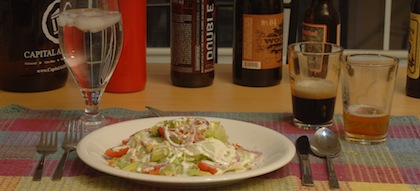Beer is for dining, finally. Wine has long hogged the dining table, consigning beer to the realm of hot dogs and ballparks. And I suppose if we are being honest, much of the yellow fizzy stuff deserved to be there.
All great meals are built on high-quality ingredients, perfectly prepared.
Things have changed. The craft beer revolution has brought a bounty of complex, delicious products to the table, perfect with a nice, crisp, white tablecloth. Since this is all a bit new, and there are not a ton of tried and true recipes, pairings and approaches. This means there’s plenty of room to have fun and move the art forward.

(Kinsley Dey)
The Fundamentals
A beer dinner can be anything from a romantic dinner for two to an intimate soirée for 1800 of your closest friends, as was the case with the recent World Beer Cup Awards Banquet, which I put together with chef Sean Paxton at a hotel in Chicago. But no matter what size the event is, the fundamentals are the same.
All great meals are built on high-quality ingredients, perfectly prepared. Beyond that, it’s helpful to consider your goals. Do you just want a nice meal—tasty food with some delicious beers? Nothing wrong with that. Is there a theme: summer, local, brewery, cuisine, beer style, decadent, down-home, picnic, porcine or artsy? Any particular beers or standout ingredients you want to showcase? How about an educational component? Having an idea really helps with all the decisions that need to be made.
There are lots of possibilities for themed events. As part of the Chicago Beer Society, I’ve helped put on events marrying Indian food with India pale ales, a German weissbier-weisswurst brunch, Belgian beer dinners, several beer and cheese events and an annual beer and barbecue competition. It’s endless.
In a dinner, flavors should progress from less to more intense, building to a crescendo with the main dish, but also changing character from one dish and beer to the next, to provide a break or a palate cleanser along the way.
Beer fans really like their food, so don’t skimp on portions. A full dinner will normally be four to six courses. You may have a highly structured format, with specific beers for each course, but it’s also fun to be a little looser, like an array of small, tapas-style plates and beers that work in various ways, letting people experiment with different combinations.
Beers are normally served in two-to-four-ounce servings, but a full glass of a thirst-quenching beer as people arrive is a good starter. It’s nice to serve every beer in its own special glass, but this is impractical in most situations, so I usually set two wine glasses at each place. This allows the second beer to be poured before the first is gone, and people can leapfrog their way through dinner this way. A pitcher of water and a dump bucket are essential. Typically, there is one beer per course, but you can serve two with the main course, and perhaps an additional beer as an after-dessert. Be aware of people’s total intake. Ten, three-ounce servings is about the max, and less if there are strong beers on the menu.











Great article though I will disagree with never reducing a beer. I make a stout pound cake where the recipe tells you to reduce the stout by a third. My friends love this cake.